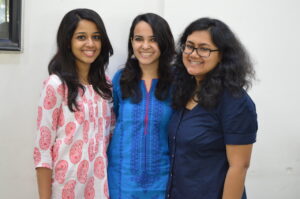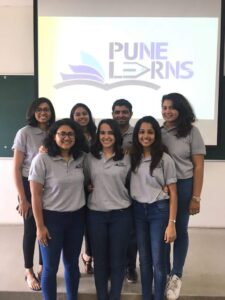Ever gone through an experience, read an article, or come across a social media trend and felt an overwhelming urge to take action? As today’s youth, more than ever, we strive to challenge the status quo and make a positive impact on the world around us. And there couldn’t be a better time. With all the negativity in society currently there’s a dire need for change-makers who can lay the groundwork for a better future. I too was in a similar situation, when I realized I wanted to work towards empowering and educating under-resourced children in Pune.
For me, the spark was a little girl, at a local community Pallavi and I volunteered at, who insisted on being taught English. She dreamed of learning to read the billboards on the road and trusted us enough to believe that we would be able to help her. After discussing this with the other children, who we had already come to know as talented and enthusiastic learners, we realized that they had just as much ambition and dedication as the little girl. What they needed was the toolset to achieve their goals, mentorship to guide them and, most importantly, the freedom to dream. Affected by this revelation, we decided to take on the challenge, starting with teaching this group of children. The next six months saw a lot of challenges, struggles, and at times, frustration. However, the progress we saw in our kids was inspiring.
Over time, I realized that I had the potential and drive to impact a lot more children across the city, and this inspired me to work towards expanding the scope of our vision.
2020 marks 5 years of Pune Learns and I can confidently say that taking the plunge was one of the best decisions of my life. Here are my top 4 takeaways from this journey in successfully starting and sustaining a nonprofit –
Believe in your cause and find the “crux”:
And I mean TRULY believe in it. Your belief will be your biggest asset while establishing your initiative and motivating others to join you. Focus on maximizing the impact your work will have on others. I was nearing my final year of college as I was going through this process and at that moment I truly felt that there was no cause I felt more strongly about, no activity that brought me more joy and satisfaction than working and mentoring these kids.
Having volunteered at several larger organizations before, I wanted to ensure that our experience was a more personalized one – through holding sessions within their home community areas, having smaller groups with an individual focus and leveraging a customized approach for each child. I wanted our model to be focused on the personal connection between each teacher-student pair, with particular emphasis on not just teaching, but on giving the children broad exposure to life skills and helping them become confident human beings.
Find the right partners and LISTEN:
The most important step of this process, the partners you find will shape your organization and set the course for its progress. I’ll never forget the day I (hesitantly) sat a couple of my friends down in a friend’s apartment to speak to them about the idea. This prompted a detailed conversation that had us brainstorming well into the night. It was encouraging to know that they were as motivated and passionate to contribute to the cause.
LISTENING is an important part of this phase to make sure you – a) effectively conveyed your cause b) addressed any reservations c) understood their passions and key drivers d) intertwined their personal purpose with the initiative’s e) recognized and defined each person’s unique future contribution.

Tanvi led the volunteer group and really understood what would keep them motivated and engaged; Pallavi, an avid reader, was passionate about setting up a mobile library; Artistic Arzoo added a creative spin to our curriculum and events; Nishant, a Debate and MUN enthusiast, led a lot of the public speaking focused segments; and Dipack was our technophile.
Research, define success and conceptualize tangible short-term and long-term:
We talk about building consumer focused solutions across all industries and the same applies to a nonprofit. The difference between nonprofit vs. other industries is that nonprofit isn’t driven by the same traditional, quantifiable KPIs (Key Performance Indicators). So it’s crucial for the group to define your target audience, value-add to their lives and what success for the organization would look like.
From the beginning, we knew that even if we could help a single child, we would consider the effort a success. Our primary goal was to see improvements in not only their English skills but also their personality traits (confidence, mannerisms) and core values.
Dive in and prepare yourself for constant change:
After that it’s just a matter of setting your plans into action. We started small, with just 2 communities initially, and focused heavily on developing an effective curriculum by consulting experts and trial and error.
We were extremely fortunate, and very quickly received an overwhelming response, which led us to incrementally broaden our reach. As we expanded, we realized that there was immense value in cross community collaboration. This changed our strategy from operating our individual communities in silos to bringing them all together to form one large community. From hosting communal volunteer on-boarding sessions and student events we saw a spike in engagement from both our volunteers and students. Similarly, with COVID-19, we are now re-adapting our operations to fit a digital first approach.
Over five years, Pune Learns grew to a family of over 300 students, 150 volunteers and 15 communities in Pune. While strenuous at times, especially because none of us were pursuing this as a full-time job, this experience has been invaluable, and I wouldn’t trade it for anything. It may never seem like the right time to pursue a cause, but with the right team, mindset, goals, and hopefully a little motivation from this blog post, you too can embark on this journey and see your dream turn to fruition. 2020 needs you!
– By Pooja Kulkarni
View this post on Medium.